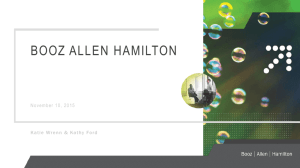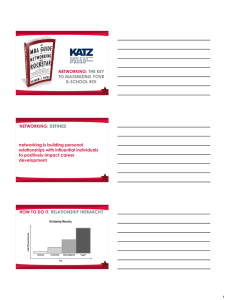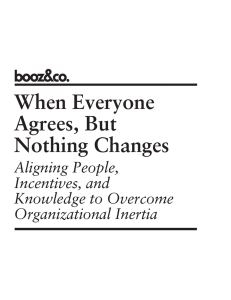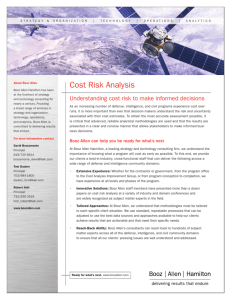UnleashingProductivity
advertisement
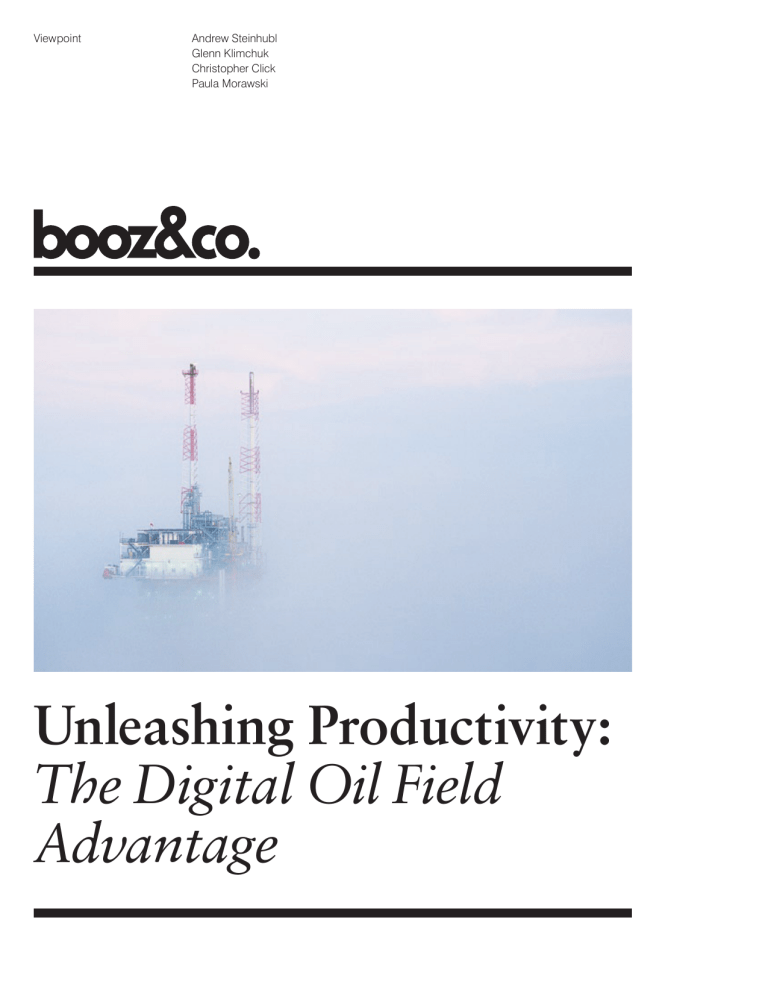
Viewpoint Andrew Steinhubl Glenn Klimchuk Christopher Click Paula Morawski Unleashing Productivity: The Digital Oil Field Advantage 02 03 The Looming Labor Shortage 04 Exhibit 1 Oil Consumption vs. Finding and Development Capital Expenditures 05 Exhibit 2 Employment Forecast Comparison 05 Defining the Digital Oil Field 06 Exhibit 3 Labor-Related Savings from Digital Oil Field Technology 12 Keys to Successful Implementation of New Operating Models 13 Exhibit 7 Program Management Center of Excellence 14 Exhibit 8 Examples of Digital Oil Field Operating Model KPIs 15 Exhibit 9 Two-Year Handoff Plans 16 Exhibit 10 Estimated Issue Processing Times Used to Determine Staffing Model 17 Conclusions 07 Building a New Operating Model Enabled by the Digital Oil Field 08 Exhibit 4 Production and Operational Surveillance Operating Model 09 Exhibit 5 Dynamic Real-Time Reporting Model Andrew Steinhubl Senior Executive Advisor 1301 McKinney Street Suite 2850 Houston, TX 77010 andrew.steinhubl@booz.com Glenn Klimchuk Principal 1301 McKinney Street Suite 2850 Houston, TX 77010 glenn.klimchuk@booz.com Christopher Click Senior Associate 901 Main Street Suite 6500 Dallas, TX 75202 christopher.click@booz.com Paula Morawski Senior Associate 225 West Wacker Drive Suite 2270 Chicago, IL 60606 paula.morawski@booz.com 10 Challenges in Adopting New Digital Oil Field Enabled Operating Models 11 Exhibit 6 Reconciling Technology and Organization Booz & Company 03 The Looming Labor Shortage Despite record oil prices and increasing demand for crude, the oil and gas industry will be inhibited in reaching its full potential for value creation unless it can solve its dilemmas regarding human capital and resources. Closing the labor and skills gaps represents one of the industry’s major—if not the primary—factors in sustaining growth and maximizing profitability against a tide of rising capital and operating costs. Industry sources estimate that demand for hydrocarbons will continue to increase to approximately 100 million barrels per day by 2015. If one uses historical spending growth rates, normalized for production growth, to extrapolate future spending levels, these demand projections imply required annual finding and development capital expenditures in excess of $500 billion by 2015 (see Exhibit 1, page 4). Because finding and development requires high-cost labor throughout the value chain under the industry’s current model for deploying human capital, the sustained trend of capital expansion will require substantial increases in field operations and engineering expertise. Booz & Company 04 In fact, historical analysis of international oil companies (IOCs) indicates a direct correlation between their finding and development capital expenditure and the number of full-time employees; from this data, we can extrapolate that the industry could ultimately require more than 4 million employees—500,000 more than it currently has. Given that IOC employment has been decreasing steadily over the past several years, if the expected “unconstrained” demand for labor is considered against this realistic labor decline, the labor gap could eventually reach as high as 1 million by 2015 (see Exhibit 2). The critical questions emerging from this analysis include where these skilled employees will come from, what the economic costs of inadequate labor supply will be, and how—if at all—the industry needs to change the way expertise is leveraged. In order to meet forecasted skill requirements and reduce the gap between supply and demand, the industry is faced with two options: 1. Increase manpower through effective supply-side strategies, such as more-rigorous succession planning, retention programs, proactive planning against upcoming vacant positions, focused mentoring, and marketappropriate compensation. 2. Reduce the need for increased staff by enabling fewer people to do more work and better leverage their expertise, ultimately changing the ways people are deployed to conduct their analytical work. This would entail a combination of increased automation, process redesign, and even increased outsourcing. The application of digital oil field technologies to enable productivity can be a powerful mechanism to address the demand-side pressures of unique asset portfolios and close the supply gap by accelerating employee productivity. Exhibit 1 Oil Consumption vs. Finding and Development Capital Expenditures 600,000 100,000 F&D CAPEX F&D Capex (Dollars in Millions) 80,000 400,000 60,000 300,000 40,000 200,000 20,000 100,000 2015E 2014E 2013E 2012E 2011E 2010E 2009E 2008E 2006 2007E 2005 2004 2003 2002 2001 2000 1999 1998 1997 1996 1995 1994 1993 0 1992 0 Oil Consumption (Thousand bbls/day) Oil Consumption 500,000 Note: Does not include national oil company capex; future F&D capex extrapolated based on historical CAGR normalized for production growth. Sources: John S. Herold; International Energy Agency; Booz & Company Booz & Company 05 Defining the Digital Oil Field Digital oil field is the umbrella term for technology-centric solutions that allow companies to leverage limited resources. For instance, such technology can help employees more quickly and accurately analyze the growing volumes of data generated by increasingly sophisticated engineering technologies, such as down-hole multiphase sensors, measurement-while-drilling (MWD) applications, multilateral completions, and down-hole separation. Generally, the digital oil field encompasses both the tools and the processes surrounding data and information management across the entire suite of upstream activities. More specifically, digital oil field technologies allow companies to capture more data, with greater frequency, from all parts of the oil and gas value chain and analyze it in real or near-real time, thus optimizing reservoir, well, and facility performance. These engineering-based and information-based technologies can have a profound positive or negative impact on human capital efficiency depending on how they are introduced and embedded into the organization. A sample set of technologies that are receiving universal industry acceptance includes the following: • Remote Real-Time Facility Monitoring and Control The off-site control of facility process systems through the networking of SCADA (systems control and data analysis) and its transfer to onshore control rooms, enabling field data capture, set point control, and valve/pump manipulation. • Real-Time Drilling The collection and integration of real-time drilling data such as RPM, circulation solids, downhole pressures captured through MWD, and remotely steerable down-hole tools. • Real-Time Production Surveillance The utilization of advanced alarm systems to trigger analysis of important production integrity Exhibit 2 Employment Forecast Comparison Required FTEs Constrained FTE Supply Full-time Employees (Thousands) 5,000 4,000 ~1.0 million full-time employees 3,000 2015E 2014E 2013E 2012E 2011E 2010E 2009E 2008E 2006 2007E 2005 2004 2003 2002 2001 2000 1999 1998 1997 2,000 Note: Illustrated gap of 1 million FTEs calculated by subtracting constrained FTE supply (assuming 1.5 percent annual decline) from estimated FTE requirements (assuming constant FTE/production ratio). Sources: Booz & Company; John S. Herold Booz & Company 06 • • • • trends to help optimize and maintain installed capacity levels. Intelligent Wells Surface-controlled, down-hole equipment, enabled by fiber-optic sensors, allows for continuous monitoring of conditions and response. 4-D Visualization and Modeling Successive 3-D seismic surveys track fluid movements, allowing for additional insight into production enhancement and redirecting enhanced recovery mechanisms. Remote Communications Technology Off-site facilities with real-time visual, voice, and data communication with the field allow more rapid, analytical responses by a mix of off-site and on-site staff. Integrated Asset Models Applications that model complete production system performance from the producing horizon, through the well-bore, through the production facility, and onto the export/sales point across disparate data sources and multisite work teams. • Workflow and Knowledge Management Systems Robust historical data and document-management solutions that allow assets and functions to quickly execute workflows and routines by calling up complete historical analyses quickly and accurately. • Production Volume Management Systems Standardized production data and production allocations, allowing more efficient real-time production decisions that result in reduced deferment and improved operational integrity. implementation; from a human capital perspective, digital oil field technologies can allow companies to operate with significantly fewer resources and scale the existing resources more effectively by capturing and displaying relevant conditions more quickly and to a wider collaborative environment. For instance, one oil and gas company has quantified its productivity-based gain from introducing select digital oil field technologies at US$20 million annually. It identified opportunities for direct deferment; by automating data updates and reports across a standardized master production data-store, the company removed the responsibility for routine data collection and analysis requirements from its scarce engineering talent (see Exhibit 3). Some industry analysis suggests improved net present value of up to approximately 25 percent from digital oil field–related Exhibit 3 Labor-Related Savings from Digital Oil Field Technology Field Data Capture Monitoring & Surveillance Develop Well Status/Meter Change Process Build Well Investigation Process Assign Process and Data Owners Assign Process and Data Owners Automate Data Feeds & Updates Develop Optimization Model (Cygnet vs. OSi) Implement HH/Laptops for Field Build Optimization Teams Process Organizational Improvement initiative Technology Build Out SCADA Mid Continent Natural Gas Employees Reservoir Engineers Production Engineers Field Operators Total 12 11 26 49 0.4% or ~$20 million of improved production Field level employees responsible for initiative Value from changing existing activity sets Source: Booz & Company Booz & Company 07 In other cases, the human capital benefits are less quantifiable but equally compelling. The benefit of digital oil field technologies is evident across the entire organization— from on-site at the field level, where new technologies can increase safety and reduce workload, to the management and executive levels, where staff benefit from increased transparency of information and direct daily production to the most advantageous markets. The digital oil field can even ease the competition for human resources between national oil companies (NOCs), IOCs, and oil field suppliers (OFSs). There are several drivers of such competition: For instance, whereas IOCs had traditionally played the role of resource extractor and NOCs were resource holders, that dynamic is shifting; with NOCs better capitalized and attempting more challenging development, more skilled people are required. In another example, OFS companies had developed their capabilities around engineering and research during the 1980s and 1990s, when IOCs were undergoing significant cost reductions. As IOCs enjoy the recent boom, however, they are trying to rebuild those capabilities internally, and need the people to do so. By pooling limited resources in technologically sophisticated environments like that of the digital oil field, each of the players can leverage its strengths and cut down on the number of people needed overall. Building a New Operating Model Enabled by the Digital Oil Field Digital oil field technologies such as fiber-optic pressure and temperature gauges allow for sustained down-hole profiling, which offers managers more robust information and thus more comprehensive asset awareness. As information flow is directed from the field to the most relevant party off-site, this complete sense of asset awareness translates directly into asset optimization, as managers can make more informed portfolio decisions in terms of resource and capital allocation. This portfolio perspective allows the best deployment of available staff and therefore has a positive impact on the industry’s most pressing issues, offering benefits such as a reduction in production deferment due to unplanned shutdowns, higher uptime across the production system, and a reduction in health, safety, and environmental incidents. By enhancing collaboration across facilities, geographic locations, and functions, global majors have strengthened lines of communication and interrelationships between the field and office and redefined the field operating model. New collaboration technologies—such as high-density video; reliable video, audio, and data transmission through fiber optics; and multidimensional presentation technologies (e.g., video cube walls)— have transformed companies’ ability Booz & Company 08 to stay globally connected 24/7 and have aligned onshore support centers, offshore facilities and operations, vendors, partners, and non-field professionals into a collective operating unit. These collaborative environments are increasingly equipped with smarter surveillance and diagnostic tools to pinpoint relevant conditions by passing real-time data through advanced multivariable models that can be scaled across multiple assets and facilities. For instance, one supermajor has deployed a new operating model that ties together remote monitoring; real-time surveillance; and reservoir, well, and facility optimization, field planning; and work activity execution into an integrated production management center (see Exhibit 4). Although early in its deployment, the operating model’s business objectives are to pay for itself and create the productivity equivalent of 19 additional engineers. To do so, it would need to reduce production deferment by a mere 0.04 percent. The key advantages of the integrated operating model are access to distributed expertise from remote locations and reduced decision time despite geographical boundaries. Other benefits include the ability to leverage lessons learned on previous projects, as knowledge management systems become more robust and historical well and facility performance profiles are generated over longer periods. Access to this information enables companies to identify the right personnel to engage for faster problem resolution. Holistically, document management databases can serve as a clearinghouse for issue status information that may affect operations and a conduit for on-demand operations optimization. This results in more comprehensive and faster operating pictures, with well histories, engineering network experiences, and past solutions being at an individual’s fingertips, rather than sitting in a desktop drive or being part of the institutional memory lost when someone departs the company. Exhibit 4 Production and Operational Surveillance Operating Model Offshore Operations Operators Centralized Surveillance Support Surveillance Technicians Integrate Activity Plans Asset Engineering Teams Well, Process, Facility Engineers Manage Opportunities Determine New Reservoir Properties Generate Options Drill & Complete Wells Dynamic Reporting Operate/Execute Production Services Well/Subsea Surveillance Facilities Surveillance Execute Production Optimization Jobs Operate and Maintain Facilities Continuous Operational Monitoring Define Operating Parameters Interpret Geological Geophysical, and Resevoir Data Pipeline Control Source: Booz & Company Booz & Company 09 Continuous monitoring or advanced surveillance activities stored in integrated knowledge repositories (e.g., databases, wikis, or analysis applications) that catalog asset and equipment history, well-test histories, decline curves, and previous optimization decision routines allow managers to maximize field value through advanced system-wide modeling and simulation analysis. However, none of this can happen without high-quality data in a consistent format. Performance dashboards and enhanced reporting capabilities permit transparency and cross-organizational knowledge transfer from the field to the management and executive layers. Collecting performance statistics through a centralized, accessible data warehouse can enable dynamic reporting of performance to partners, regulatory bodies, and executive management (see Exhibit 5). For instance, static reports produced for one offshore asset at a global supermajor include alarm trends, well performance, topside performance, downtime, equipment availability, and bad actor reporting. Executives can parlay this type of asset transparency to manage performance across a wider portfolio of assets: Using integrated asset models that predict how changing one part of the system will affect the overall portfolio, executives can more effectively allocate resources and make decisions that maximize value. The overarching benefit of an operating model that makes the best possible use of digital oil field technologies is clear. It solves the information dilemma by knowing what field data to capture and how to interpret that data, resulting in field optimization, improved safety, cost reduction, and production enhancement. Better yet, it does so while enabling automated operations, carried out without any compromise of health, safety, environmental standards, or asset-realization results. Exhibit 5 Dynamic Real-Time Reporting Model Surveillance Data Management Offshore Engineering Team Respond to Routine Requests for Data Management Provide Hub for Real-Time Surveillance Data Master PIant Historian Live Feeds Alarm Trends Produce Dynamic Surveillance Reports Static Feeds Well Performance Facility/Topside Performance Knowledge Management Regulatory Partner Live 24x7 Dashboards Planned vs. Actual Downtime Issue Resolution Source: Booz & Company Continuous Monitoring (Vendor Data) Continuous Monitoring (PIant) Historical Performance Bad Actor Reporting Operating Guidelines Equipment Availability and Performance Booz & Company 10 Challenges in Adopting New Digital Oil Field Enabled Operating Models When digital oil field technologies achieve less than their envisioned potential, it is most often because the technologies outstrip the organization’s ability to absorb them. Upstream companies face a dual challenge: first, integrating a relevant technology into existing oil field and IT infrastructures, and then working through the ripple effects of the new technology on the organizational infrastructure. In designing technology-intensive value chains for the digital oil field, companies must consider common business challenges and elements of organizational complexity, from conditions to process to implementation (see Exhibit 6). Implementing the digital oil field will have a definite impact on the organization at the field, management, and executive levels. Explicit and tacit role definitions, skill sets required for successful fulfillment of particular staff positions, and organizational enablers such as decision rights will all change, and this organizational change must be effectively managed. Field level: The key issue in implementing the digital oil field at this level of the organization is a limited degree of acceptance from operating personnel. The major hurdles to adopting the technology include: • Lack of willingness to accept significant organizational change and adjust work practices • Technology that is not “fit for purpose” and does not meet the local work requirements • Staff that is not involved in establishing functional and systems requirements nor in vendor selection • Not allowing staff time away from their normal activities to work on technology implementations (potentially solved through contractors) • Lack of dedicated internal champions • Inadequate training to prepare and support them in using the new tools effectively Management level: The key issue here is that siloed work environments must be broken down to allow for communication and interchanging roles across disparate operating groups. The hurdles are: • Ineffective resource allocation across projects and other initiatives • Lack of role definition and alignment of decision rights as off-site, on-site, and service company employees are integrated into a new interlocking model • Embedded skill sets that don’t grow in tandem with the adoption of digital oil field tools and applications, with more time spent analyzing larger portfolios of reservoirs • Gain-sharing agreements not established with service providers Executive level: Finally, at the executive level, we see three issues: a lack of top-down encouragement, a failure to make a compelling case for technology adoption, and an unfavorable environment to risk taking. The challenges to technology adoption include: • Not having the resources, both capital and staff, to support the transition • Implementation that is not coordinated across far-flung global enterprises • Strategic value proposition that is ineffectively communicated in terms of total system value, resulting in limited buy-in • Short-term operating targets that are not adjusted Booz & Company 11 Exhibit 6 Reconciling Technology and Organization Adoption success requires managing across three elements of complexity Conditions Process Determining Asset Requirements Asset complexity Leveraging Technology Established architectures Functional requirements Technology requirements Existing investments Off-the-shelf vs. custom development Integration vs. best of breed Ensuring Process Effectiveness Process ownership Replication/standardization Simplification Ensuring People Effectiveness User ease and utility Ensuring Data Integrity Automation FDC and Measurement Real-time data collection Production Reporting and Surveillance Daily performance Production Allocation and Accounting Zonal performance Marketing opportunity capture Well stock Manual and automated alarming and intervention Deferment management Net performance Price application Contractual management Nomination management Data ownership 3rd party accounting Decision rights Revenue Accounting Outsourcing effect Communication Future state defined Leadership and Stakeholder Acceptance Executive involvement Business Case/ Justification Deferment reduction Price application Mutual understanding Business units gatekeeper Intervention improvement Key Considerations • Global Vision •Business case articulated to senior management • Standard process models •Well defined functional and system requirements • BU/Corporate alignment •Internal project and implementation management capability Labor effectiveness Project Management and Vendor Alignment Allocations NRI/GWI accounting Gas Plant, P/L Accounting Established Vision Optimization Traceability Data models Culture and Behaviors Production forecast Roles and responsibilities Training Implementation Plan Production Volumes and Capacities Global coordination BU program execution Strategic partner Risk management Functional and Systems Requirements BU basis Implementation Strategy and Road Map BU resourcing Asset complexity IT infrastructure Plan robustness Contractual/PSC Marketing arrangements Management Reporting State/fed reporting Partner reporting Operations and management reporting Source: Booz & Company Booz & Company 12 Keys to Successful Implementation of New Operating Models Proving the maxim that technology cannot be a solution in and of itself but only an enabler of enhanced performance, two major organizational levers predict digital oil field success: capability development and organizational alignment. Capability development: Building an organization’s capabilities by harnessing and disseminating knowledge effectively is a critical requirement for digital oil field success. Previous reductions of oil field head counts and more recent retirement-based reductions open up the possibility that tacit knowledge, experiences, relationships, and solutions will be lost, as low-value tasks are automated and real-time data is gathered and transmitted. Despite recent investment in knowledge management systems, today’s modern oil and gas companies continue to struggle to find effective ways to transfer their inherent knowledge capital between teams, between generations of employees, between subject matter experts, and across functional and reporting layers. Developing a knowledgesharing mind-set entails a significant commitment to training people and developing a distributed learning infrastructure in which lessons learned and previous engineering work are documented, accessible, and quickly distributed to deliver maximum value. Employees at every level of the organization need to be taught and motivated to recognize opportunities to institutionalize knowledge and learning. As such, field, divisional, and personal performance contracts must be adjusted to align organizations with this inevitable operating condition. Booz & Company 13 In the operating environment enabled by the digital oil field, staff must have the skills to interpret complex data models, as well as the ability to manage a more dynamic work environment in which production parameters are altered daily instead of weekly or monthly to leverage the value of more accurate and comprehensive real-time data. Developing training simulations that model real-world operating scenarios represents a powerful medium to ensure adequate operatinglevel employee skills. As part of this learning process, digital oil field environments can be simulated so that newly aligned staff must operate under a set of new procedures and business rules and respond to designed scenarios. Such scenariobased simulations allow the organization to test alternatives and highlight issues of staff proficiency and organizational inefficiency. At the management level, skill and capability gaps can be closed more quickly by leveraging knowledge across previously autonomous operating units. Accordingly, scarce resources and expertise can be most effectively deployed through collaboration centers that allow for fluid skill and document transfer across disparate functions and assets utilizing automated workflows. Locally based collaboration centers Exhibit 7 Program Management Center of Excellence Major Elements of the Program Management Centers of Excellence Operating Model Vision and Purpose Documentation and Control Vision, Objectives, and Purpose Asset Requirements Knowledge Capture Program Office Meeting Purpose and scope Wells - Rate and phase - Operating guidelines Team and subject matter experts Directing or guiding Project status and needs Implementing vs. advising Best practices Information system plan adjustment Facilities - Compression performance - Rotating equipment integrity Application database Change Control Workflow Subsea - Flow line assurance - POD integrity Issues log Information flow Scope creep tracking Data model Functional gaps Roles and responsibilities Manage governance model Processing System - System pressure Expenditure or benefit tracking Program Office Export System - Pipeline control Project Closure Automation Benefit measurement Infrastructure Initiative description Telecommunications Risk Assessments Key learnings Application Risk number Close out authorization Define support model Define sub-programs and components Information system plan Guiding Council Technology leader Functional leadership Tech services leadership Project manager Vendor manager BU project managers Potentially permanent role in COE Staff requirements Implementation Management Process Model Definition Technical Model Definition Clear description Change Management Project Planning Baseline likelihood assessment Training Project initiation documentation (PID) Monthly residual risk assessment User communication Asset tracking Value impact Job descriptions Covers scope, deliverables, benefits, milestones, risks, dependencies Graphical presentation RACI development Associated economic-based analysis Progress Reporting Weekly program meeting Monthly board meeting Source: Booz & Company Booz & Company 14 such as drilling, remote monitoring, system surveillance, and production optimization in conjunction with global “centers of excellence” (COEs) provide deep yet scaled knowledgebased organizational levers that aggregate and standardize processes and skills at the appropriate levels in the organization while better concentrating and deploying scarce subject-matter expertise. By generating both local and enterprise-wide knowledge, these centers concentrate knowledge, ensure consistent transfer of skills, monitor functional delivery, and ensure continuous communication with asset, operational, and functional stakeholder groups. The focus of these COEs can be on any of the elements of a new capability, operating model, or major technology being implemented: For instance, one oil and gas company’s production management center implementation has combined processes for the documentation of asset requirements, risk assessment, best practices, and existing protocols with program management office functions to plan for and implement technology solutions (see Exhibit 7). These COEs help reduce digital oil field–related adoption risk by stewarding and testing new technologies, building training programs that accelerate organizational adoption, and leveraging project management knowledge to ensure budgets and schedules are met. Exhibit 8 Examples of Digital Oil Field Operating Model KPIs Type (outcome, output, activity) Data Source a. Number of engineers using services (workflow completed) b. Number of times services executed a. Activity b. Output Objective 2: Conduct surveillance services to reduce decision cycle time for engineers a. Percent of services completed within schedule Objective 3: Extend scope and coverage of high-priority surveillance activities a. Percent of ad hoc requests for surveillance services Objectives Measure Objective 1: Off-load engineers to facilitate identification of high-value optimization opportunities Stakeholder (to whom is it reported out?) Frequency of Reporting Data Owner (who owns this data?) a. SharePoint workflow b. SharePoint workflow – Surveillance Managers/Production Surveillance Manager – PLT – Monthly – Quarterly – IT/Surveillance Systems Technician a. Outcome a. SharePoint workflow – Surveillance Managers/Production Surveillance Manager – PLT – Monthly – Quarterly – IT/Surveillance Systems Technician a. Activity a. SharePoint workflow – Surveillance Managers/Production Surveillance Manager – PLT – Monthly – Quarterly – IT/Surveillance Systems Technician Source: Booz & Company Booz & Company 15 Aligning the Organization The ability of a company, a business unit, or a team to execute a strategy is not something that can be mandated by fiat. It is inherent in the organization’s DNA and expressed in the hundreds of decisions and actions that collectively constitute and define performance. Would-be digital oil field operators can, however, attempt to align the building blocks of a company’s DNA—decision rights, information flows, organizational structure, and motivators—to better capture the digital oil field’s benefits. In order to realize the full potential of digital oil field technologies, organizations must be aligned and interrelationships established— for instance, between engineering functions, assets, and functional reporting relationships through an integrated set of key performance indicators (KPIs) (see Exhibit 8). A significant part of organizational alignment will involve creating new roles, redesigning existing processes, and aligning performance measures to support and execute collaborative working conditions. In addition to aligned operating model KPIs, the process of creating new roles must begin with a robust analysis of labor supply and demand dynamics, in which present and future capability gaps are clearly understood. The supply analysis provides insight into potential areas of concern, such as high turnover, recruitment constraints, and the impact of retirement eligibility on the company’s ability to effectively utilize technology solutions. The demand analysis provides a baseline understanding of how work is distributed across the organization Exhibit 9 Two-Year Handoff Plans Degree of Complexity 0 1 2 3 4 Degree of Complexity 5 0 1 2 3 4 Degree of Complexity 5 0 Current State Implementation Year 1 Implementation Year 2 Surveillance Engineers Surveillance Engineers Surveillance Engineers Surveillance Technicians Surveillance Technicians Surveillance Technicians Example Tasks Example Tasks Example Tasks Routine Monitoring Advanced Monitoring Well Ramp Monitoring Rotating Equipment Monitoring Adjust Chemical Injection Rates Sluggish Management Monitoring Chemical Management Optimization System-Wide Monitoring Management 1 2 3 4 5 Source: Booz & Company Booz & Company 16 and how the current levels of staffing and competencies are used to perform work. It also yields an understanding of anticipated changes in the nature, type, and quantity of the work, including changes resulting from the new business process flows and technology introductions. Formal capability development associated with integrating new digital oil field–related skills should be an integral part of today’s oil company staffing models and must inherently consider the degree of changing work task complexity, technology adoption, and skill transfer timing requirements. Exhibit 9 shows a high-level two-year handoff plan associated with transferring lowercomplexity tasks from surveillance engineers to surveillance technicians within a newly established production operating center. The complexity associated with various tasks should similarly guide resource allocation models and hiring plans to determine the adequate number and type of staff needed for digital oil field enabled environments. Analysis of the time associated with completing tasks of varying complexity can be used to derive staffing estimates, both as production is starting up and once it enters a steady state (see Exhibit 10). The staffing model similarly represents a key complement to the labor supply and demand analysis discussed previously. Exhibit 10 Estimated Issue Processing Times Used to Determine Staffing Model Start-up 2007 Steady State 2009 August 2007 Issue Complexity (Time in Minutes) Low Moderate High Seasoned 20 45 60 Some Experience 30 75 New Hire 60 120 February 2008 Issue Complexity (Time in Minutes) August 2008 Low Moderate High Seasoned 15 40 60 120 Some Experience 15 40 180 New Hire 15 40 Experience Issue Complexity (Time in Minutes) Low Moderate High Seasoned 15 40 60 60 Some Experience 25 60 100 90 New Hire 60 120 180 Experience Experience February 2009 Issue Complexity (Time in Minutes) Low Moderate High Seasoned 15 40 60 Some Experience 15 40 60 New Hire 15 40 90 Experience Source: Booz & Company Booz & Company 17 CONCLUSIONS Digital oil field technology applications, such as real-time drilling centers and collaborative decision environments, align multiple, previously disparate activity sets into a collective operating unit that must function cohesively. For these multifunctional teams, composed of off-site staff and non-field professionals, to operate effectively and in close partnership, managers must leverage certain organizational enablers to establish collaborative working relationships. These organizational enablers entail clearly defining decision rights and reestablishing accountabilities across functions that have previously operated in silos. This digital oil field–enabled model will more efficiently deploy human capital and reduce the supply/demand dislocation the industry faces. It’s not a quick fix: Implementing such a new model requires a combination of process change, organizational change management, and technology application efforts. But without these advances, oil and gas companies will find themselves caught between the conflicting pressures of a shrinking labor force and a growing demand for oil. The digital oil field can help launch a fundamentally more effective organizational model—leveraging technical and cross-functional expertise, as well as better vertical and horizontal decision making. Booz & Company 18 About the Authors Andrew Steinhubl Andrew Steinhubl is a senior executive advisor with Booz & Company in Houston. He heads the firm’s North American work in upstream oil and gas, and has worked with many companies on process, organization, and technology issues, as well as the integration of these issues to achieve an overall agenda. He can be reached at 713-650-4183 or andrew.steinhubl@booz.com. Paula Morawski Paula Morawski is a senior associate with Booz & Company in Chicago. She works with oil and gas companies to successfully navigate organizational change, with a focus on human capital and learning. She can be reached at 312-578-4809 or paula.morawski@booz.com. Glenn Klimchuk Glenn Klimchuk is a principal with Booz & Company in Houston. He specializes in helping oil and gas companies manage the convergence of people, processes, and leading-edge technologies into new operating models and overcoming such models’ inherent adoption challenges. He can be reached at 713-650-4181 or glenn.klimchuk@booz.com. Christopher Click Christopher Click is a principal with Booz & Company in Dallas. He focuses on helping oil and gas companies improve organizational effectiveness and human capital productivity. He can be reached at 214-746-6543 or christopher.click@booz.com. Booz & Company 19 Printed in USA ©2008 Booz & Company For more information about Booz & Company, visit www.booz.com Worldwide Offices Asia Beijing Hong Kong Seoul Shanghai Taipei Tokyo Australia, New Zealand, & Southeast Asia Adelaide Auckland Bangkok Brisbane Canberra Jakarta Kuala Lumpur Melbourne Sydney Europe Amsterdam Berlin Copenhagen Dublin Düsseldorf Frankfurt Helsinki London Madrid Milan Moscow Munich Oslo Paris Rome Stockholm Stuttgart Vienna Warsaw Zurich Middle East Abu Dhabi Beirut Cairo Dubai Riyadh North America Atlanta Chicago Cleveland Dallas Detroit Florham Park Houston Los Angeles McLean Mexico City New York City Parsippany San Francisco South America Buenos Aires Rio de Janeiro Santiago São Paulo Booz & Company Booz & Company www.booz.com Summer 2008 Booz & Company is a leading global management consulting firm, helping the world’s top businesses, governments, and organizations. Our founder, Edwin Booz, defined the profession when he established the first management consulting firm in 1914. Today, with more than 3,300 people in 57 offices around the world, we bring foresight and knowledge, deep functional expertise, and a practical approach to building capabilities and delivering real impact. We work closely with our clients to create and deliver essential advantage. For our management magazine strategy+business, visit www.strategy-business.com. Visit www.booz.com to learn more about Booz & Company.
